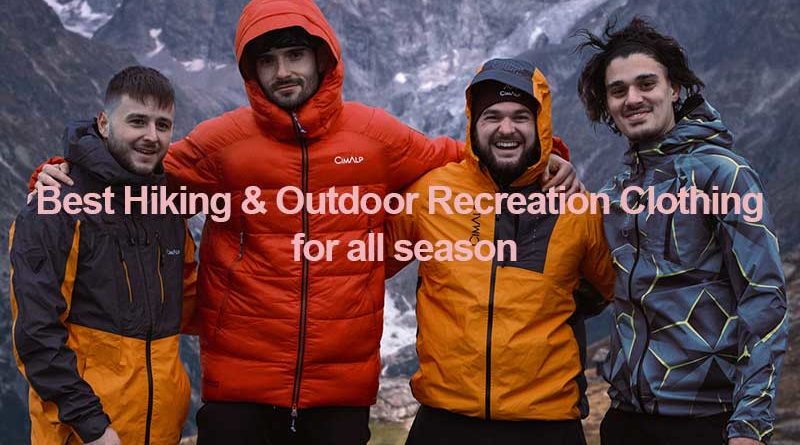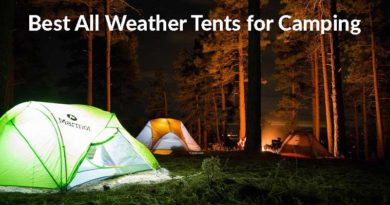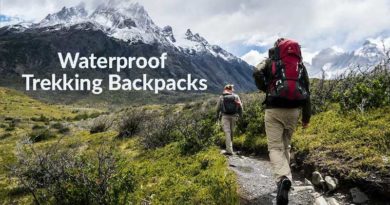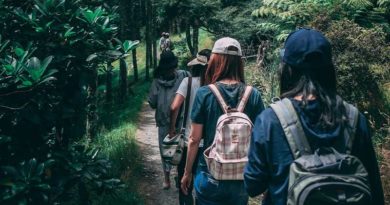Best Hiking & Outdoor Recreation Clothing for all season
Everyone deserves to take a break from an autonomous daily routine and there is no better option than going on trekking and recharging yourself. If you have ever been on treks, you must know what to prepare beforehand and if it is your first time going on trekking then you are on the right page because, in this blog, we will share some important information on what to wear in trekking.
In India, the Himalayas offer one of the best scenic and adventurous places that offer trekking, hiking, and many other adventure recreation activities. Although, India has an abundance of adventure places but the Himalayas are the most popular for hiking and outdoor recreation for all seasons and it has a never-ending list of spectacular hill stations.
So, after all the planning and itinerary of trekking, the crucial part is packing your bag and we are sure that if it is your first time, you will definitely be confused about exactly what to pack and what to wear in trekking. But, to tell you the truth, you don’t need to worry about it at all because we are here with a complete guide of trekking clothing for all seasons. Let’s take a look.
Certainly, nothing is better than comfort, and to make your trekking more enjoyable and stress-free, it is always a good idea to plan ahead and pack your camping gear and other essentials.
Check an ultimate list for your trek-day essentials: – https://www.ourhimalayas.com/recomendations/
And, if you have a longer schedule for trekking and outdoor adventure activities then you must check this category-based list that covers every aspect from first-aid to trekking gears to entertainment: – https://theglobalcurious.com/blog/ultimate-camping-list-printable-camping-checklist
What to Wear in Trekking– Basics
- Inner-Wears – First Layer: – Since the inner wears or undergarments are the first layer of clothes next to your skin, you must not rely on your regular comfy cotton bras and boxers. It has to be wool/thermal in winter to keep you warm and synthetic in summer to manage moisture.
You must cut out cotton from the list and must include nylon, polyester, and merino wool because these fabrics will move away from the moisture from the body, helping prevent chafing, and uncomfortable wetness. - Pants: – You can prefer pants, shorts, skirts, dresses, or leggings depending on the climate but they must be made of quick-drying material and give you comfortable freedom of movement. Its length and thickness also matter a lot because environmental hazards such as sharp rocks, poison, and ticks play a common role during trekking. Even a small rock scrambling can tear up your thin yoga pants and insects may climb up on your bare legs and bite on your skin if the length is not enough.
Most importantly, paying attention to fit, comfort, breathability, and durability along with the length and thickness of your pants are necessary. Jeans aren’t ideal for trekking because they are hot in warm weather and keep moisture in cool weather.
Likewise, it is not a good idea to choose too loose pants because they could cause rashes on your thighs. And, if you are going to trek in the rainy season then you must bring heavy-sustained rain-pants and convertible pants for multi-day treks.
Check the best tips to hike in rain: – https://www.thegonegoat.com/inspiration-and-tips/hiking-in-the-rain-tips - Shirts or T-Shirts: – You can wear any short/long-sleeved t-shirt or shirt but make sure that they are comfortable and do not kill your armpits. The main point you must consider here is wicking that will keep you sweat-free. The wrong fabric can leave your whole back exposed to sweat and will consequence skin rash or cold because the t-shirt will support your backpack and rubs your skin.
You are advised to go with synthetic in summers and merino-wool-based fabric in winters. You can also buy SPF-protected t-shirts to save your pain in spring and summer. - Insulating Jackets: – The type of jacket depends on the season you are trekking in and the best rule of thumb is that it should be packable-removable-windproof. Your trekking jacket should be made of synthetic material for summers and wool-down for winters.
If it is made of down-material, jacket insulation will not work. Make sure it has built-in layers and is comfortable to wear, lightweight, and easy to remove and pack in your bag. - Waterproof Jackets: – During trekking, if there are chances of rain (it is a must to check the weather report before going to trek) then you must choose a waterproof jacket. An insulating jacket will not work if it gets wet.
Beware that some water-resistant jackets will make you feel trapped in a plastic heater. A waterproof jacket must have durable water repellent coating.
How does durable water repellency work? Check here: – https://www.gore-tex.com/blog/restore-durable-water-repellency-raingear - Head Gears: – Head gears or hats in the trekking are for all seasons and are as equally important as the trekking shoes. A hat will keep your head warm in winters, dry in rain, and sun off in summers. You can choose a hat, cap, or beanie that best fits the weather condition.
You can wear a hat or cap in summer and rain and pair a beanie with a scarf in cold weather. Generally, the human body loses 7% to 10% of body heat through the head, so you should consider a hat liner for trekking no matter what the weather condition is. We recommend you purchase a durable and practical hat while being fashionable.
You can choose from a wide variety of hats from – https://www.amazon.com/dp/B001GBCXF2?tag=tgcmartinagro-20&linkCode=ogi&th=1&psc=1 - Trekking Shoes or Boots: – What kind you should wear needs detailed attention because shoes are the most important part of trekking. Keep in mind that your regular outdoor shoes are not trekking shoes. Some people use flip-flops, trail-runners, sandals, and crocs which have never been a good idea and are hugely impractical.
You can choose trekking boots that give ankle support and traction. For rainy seasons, you must choose waterproof and durable shoes and for short summers trekking, you can buy trekking sandals. And for flat terrains, a pair of comfortable sneakers is all you need. For rocky and elevated terrain, you must go with sturdy trekking boots that provide ankle protection.
So, it is suggested to buy proper trekking shoes to make your trek-time comfortable and pain-free. Otherwise, you may get injured and spoil things for real.
You can purchase trekking shoes here: – https://www.amazon.com/dp/B073WGGTQ5?tag=tgcmartinagro-20&linkCode=ogi&th=1&psc=1 - Trekking Socks: – Pairing the right socks with trekking shoes is equally important. You must stay away from the cotton socks and choose breathable socks for real comfort because cotton absorbs the sweat and will keep your feet wet throughout the trek.
And if you are trekking with exposed legs then you must choose the socks that can cover up to your knees. If your socks are not made with breathable fabric, it will leave your feet soaking wet and can cause skin irritation or any kind of allergy.
Additionally, the socks must not have air pockets and frictional fabric because it will rub your skin while walking and will cause tenderness and blisters. Uncomfortable and wrong fabric socks are prone to foot blisters and will give you a miserable trekking experience.
So, it is advised to get socks lines are you can purchase the right trekking socks here: – https://www.amazon.com/dp/B07117PVS8?tag=tgcmartinagro-20&linkCode=ogi&th=1&psc=1 - Ankle Gaiters: – Now, ankle gaiters are the most important but overlooked items for trekking. If you are trekking in intense weather conditions and rough terrains, ankle gaiters are must-have items to pack.
These gaiters cover your shins, block debris from the bush whacking, and water when crossing the streams, and provide proper insulation that keeps your feet comfortable and makes you happy. Most of the trekkers use these gaiters only in rainy climates but you can choose lighter gaiters to use in summers. - Neck and Hands Protective Gears: – To protect your hands in rainy and cold weather, it is suggested to go for moisture-wicking gloves. And to protect your neck, you can use wool or fleece gaiter. You may feel that these items are bulky and not-so-necessary but still, you should carry them and be prepared to use them because it’s better safe than sorry.
You can buy the neck gaiters here: – https://www.amazon.com/dp/B08DTWG8R6?tag=tgcmartinagro-20&linkCode=ogi&th=1
Now that we have basic clothing considerations for trekking in different seasons, let’s get more specific by each season.
Sun Protective Clothing – SPF Protection
These days, a big part of trekking clothing also involves SPF-protected clothes to provide you protection from direct sunlight in all seasons. It is very important to give extra attention to your skin in this ozone-affected world. When you are hitting the trails without proper sun protection, your skin will pop up due to sunburns, especially on the neck and shoulders, and will ruin your trekking experience. You must not expose your skin to direct sunlight.
Blend your clothes with Nature
The greatest rule of thumb here is to blend the clothing tone with nature. Many people choose bright colors as per their choices but when it comes to heat absorption, dark colors will keep you warm and light colors will keep you cool.
When you are hitting the trails, the heat flows two ways. One is that you receive from the sun and weather and the other is that your body creates and drives out. So, depending upon the natural cooling of your body and sweat conditions, you must choose the type of fabric and layers accordingly. Moisture-wicking clothes are the best bet in every season.
Summers
Summers call out for lighter shades and breathable moisture-wicking clothes. The moisture-wicking fabric will save you from skin irritation, itching, and blisters on your back where your bag-pack rubs your skin.
Trekking in the summers gives flexibility and freedom to choose your favorite clothes. You can wear your favorite shorts and pair your dashing sunglasses with a fashionable hat. A white color t-shirt will absorb less heat and will keep you cooler and the dark colors attract unwanted insects and bugs and absorb more heat. Although it is tempting to wear shorts and tank tops but long-sleeved shirts and long pants offer extra protection.
Winters
Trekking in winter is a totally different experience and it’s worth making extra efforts to admire nature’s beauty in winter. You can wear budget-friendly wool or synthetic layers to keep you warm. Do not forget to pack an extra layer because you never know when you may need that.
Make sure the clothes you choose keep your body temperature-controlled and comfortable and give you moving flexibility. Sweat-wicking base layer, long sleeve t-shirt, and a fleece or wool-made head/neck gear are the most important items for trekking in winter.
Spring
It is easy to select a mix of clothing for trekking in the spring season. You need to prepare for both wind and rain in this season. So, you must choose a waterproof upper layer of clothes, ankle gaiters, and rain-proof shoes. Water-resistant and convertible clothes are the most important part of trekking in the spring season.
In early spring, you can choose more layers and in late spring, you can choose lesser layers of clothes but make sure to keep them water-resistant and moisture-wicking.
In Conclusion
After all the specifications of what to wear in trekking, the bottom line for a great trekking experience is to check the weather report for the day of your trek. Plan and pack everything you need on trekking and check the trekking day weather report following the next 48hours. It will give you a better sense of weather conditions and help you plan accordingly. We would suggest you pack one layer of clothes beyond what you have packed as per your requirements.



